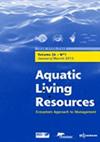克服毛竹种子生产限制,满足联合国生态系统恢复十年的需求
IF 1.9
4区 农林科学
Q3 FISHERIES
引用次数: 0
摘要
欧洲平生牡蛎(Ostrea edulis)是一种栖息地形成的双壳类动物,历史上广泛分布于整个欧洲。由于过度捕捞、污染、沉积、入侵物种和疾病导致其数量下降,欧波利斯及其床现在被OSPAR列为受威胁和/或下降的物种和栖息地。人们越来越认识到牡蛎的困境,以及快速发展的恢复技术和对海洋恢复的兴趣,导致了最近栖息地恢复工作的快速增长。毛竹种子供应目前是欧洲扩大生境恢复工作的主要瓶颈。O. edulis已经被培养了几个世纪,然而,随着20世纪70年代早期太平洋牡蛎(长牡蛎)被引入欧洲,对其文化的研究减少了。由于恢复项目的时间表和资金通常较短,或者项目没有适当地规划投资、研发和商业生产者提供牡蛎种子所需的时间尺度,最近为恢复栖息地目的而更新孵化和池塘生产O. edulis种子的努力受到阻碍。此外,修复的资金是断断续续的,使得生产者和修复从业者之间的长期承诺变得困难。为了克服这些瓶颈,实现欧洲目前雄心勃勃的修复目标,需要在研究和生产方面进行长期战略投资。本文章由计算机程序翻译,如有差异,请以英文原文为准。
Overcoming Ostrea edulis seed production limitations to meet ecosystem restoration demands in the UN decade on restoration
The European flat oyster, Ostrea edulis, is a habitat-forming bivalve which was historically widespread throughout Europe. Following its decline due to overfishing, pollution, sedimentation, invasive species, and disease, O. edulis and its beds are now listed as a threatened and/or declining species and habitat by OSPAR. Increasing recognition of the plight of the oyster, alongside rapidly developing restoration techniques and growing interest in marine restoration, has resulted in a recent and rapid growth in habitat restoration efforts. O. edulis seed supply is currently a major bottleneck in scaling up habitat restoration efforts in Europe. O. edulis has been cultured for centuries, however, research into its culture declined following the introduction of the Pacific oyster, Crassostrea gigas to Europe in the early 1970 s. Recent efforts to renew both hatchery and pond production of O. edulis seed for habitat restoration purposes are hampered by restoration project timelines and funding typically being short, or projects not planning appropriately for the timescales required for investment, research-and-development and delivery of oyster seed by commercial producers. Furthermore, funding for restoration is intermittent, making long-term commitments between producers and restoration practitioners difficult. Long-term, strategic investment in research and production are needed to overcome these bottlenecks and meet current ambitious restoration targets across Europe.
求助全文
通过发布文献求助,成功后即可免费获取论文全文。
去求助
来源期刊

Aquatic Living Resources
农林科学-海洋与淡水生物学
CiteScore
2.30
自引率
0.00%
发文量
10
审稿时长
>24 weeks
期刊介绍:
Aquatic Living Resources publishes original research papers, review articles and propective notes dealing with all exploited (i.e. fished or farmed) living resources in marine, brackish and freshwater environments.
Priority is given to ecosystem-based approaches to the study of fishery and aquaculture social-ecological systems, including biological, ecological, economic and social dimensions.
Research on the development of interdisciplinary methods and tools which can usefully support the design, implementation and evaluation of alternative management strategies for fisheries and/or aquaculture systems at different scales is particularly welcome by the journal. This includes the exploration of scenarios and strategies for the conservation of aquatic biodiversity and research relating to the development of integrated assessment approaches aimed at ensuring sustainable and high quality uses of aquatic living resources.
 求助内容:
求助内容: 应助结果提醒方式:
应助结果提醒方式:


